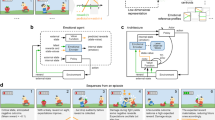Abstract
In the crossroad between Artificial Intelligence and Digital Entertainment we find the technologies to create characters that are adaptable to new situations, unpredictable, fast learners, enabled with memory of past situations and a variety of consistent and convincing behaviour over time. According to recent studies in the fields of Neuroscience and Psychology, the ability to solve problems is not only related to the capability to manipulate symbols, but also to the ability to explore the environment and to engage into social interactions, which can be expressed as emotional phenomena. The results of these studies characterize the key role that personality and emotions play in the activities of perception, attention, planning, reasoning, creativity, learning, memory and decision making. When modules for handling personality and emotion are incorporated into an agent architecture, it is possible to build believable agents. In the present work, we introduce a computer architecture to build believable agents enabled with personality and emotion.
Access this chapter
Tax calculation will be finalised at checkout
Purchases are for personal use only
Preview
Unable to display preview. Download preview PDF.
Similar content being viewed by others
References
Bates, J.: The Role of Emotion in Believable Agents. Communications of the ACM, 122–125 (1994)
Bordini, R.H., Hübner, J.F., Wooldridge, M.: Programming Multi-Agent Systems in AgentSpeak using Jason. Wiley Interscience, Chichester (2007)
Bates, J., Loyall, A.B., Reilly, W.S.: An architecture for action, emotion, and social behavior. In: 4th European Workshop on Modelling Autonomous Agents, Martino al Camino (1992)
Bower, G.H.: Mood and memory. American Psychology, 129–148 (1981)
Byl, P.B.: Programming Believable Characters For Computer Games. Charles River Media, Hingham (2004)
Damásio, A.R.: Descartes’ Error: Emotion, Reason, and the Human Brain. Putnam Publishing, New York (1994)
Davidson, R.J.: On emotion, mood, and related affective constructs. In: Ekman, P., Davidson, R.J. (eds.) The Nature of Emotion. Oxford University Press, New York (1994)
Fehr, B., Russell, J.A.: Concept of emotion viewed from a prototype perspective. Journal of Experimental Psychology, 464–486 (1984)
Gebhard, P.: ALMA: a layered model of affect. In: Proceedings of The Fourth International Joint Conference on Autonomous Agents and Multiagent Systems, Utrecht (2005)
Gazzaniga, M.S., Heatherton, T.F.: Psychological Sciences: Mind, Brain, and Behavior. W.W. Norton, New York (2006)
Izard, C.E.: Four Systems for Emotion Activation: Cognitive and Noncognitive Processes. Psychological Review, 68–90 (1993)
Jiang, H., Vidal, J.M., Huhns, M.N.: EBDI: An Architecture for Emotional Agents. In: Proceedings of the 6th International Conference on Autonomous Agents and Multiagent Systems, Honolulu (2007)
Kasap, Z., Moussa, M.B., Chaudhuri, P., Magnenat-Thalmann, N.: Making them remember - emotional virtual characters with memory. IEEE Computer Graphics And Applications, 20–29 (2009)
Kshirsagar, S., Magnenat-Thalmann, N.: A multilayer personality model. In: Proceedings of The 2nd International Symposium on Smart Graphics, Hawthorne (2002)
Kasap, Z., Magnenat-Thalmann, N.: Intelligent virtual humans with autonomy and personality: State-of-the-art. Journal of Intelligent Decision Technologies, 3–15 (2007)
Laird, J.E.: Extending the Soar Cognitive Architecture. In: Proceeding of the 2008 Conference on Artificial General Intelligence, Amsterdam (2008)
Ledoux, J.E.: The Emotional Brain. Simon And Schuster, New York (1996)
Laird, J., van Lent, M.: Behavior Modeling in Commercial Games. AI Magazine, 15–25 (2001)
McCrae, R.R., Costa, R.T.: A Five-Factor Theory of personality. In: Pervin, L.A., John, O.P. (eds.) Handbook of personality: Theory and research, Guilford, New York (1999)
Mehrabian, A.: A General Powerful System for Assessing Temperament Personality (2009), http://www.kaaj.com/psych/scales/temp.html (cited March 15, 2010)
Mehrabian, A.: Pleasure-arousal-dominance: A general framework for describing and measuring individual differences in Temperament. Current Psychology, 261–292 (1995)
McCrae, R.R., John, O.P.: An Introduction to the five-Factor model and its applications. Journal of Personality, 175–215 (1992)
Morris, W.N.: A functional analysis of the role of mood in affective systems. Review of Personality and Social Psicology, 256–293 (1992)
Nareyek, A.: Intelligent Agents for Computer Games. Computers and Games, 414–422 (2001)
Niedenthal, P.M., Halberstadt, J.B., Margolin, J., Innes-Ker, A.H.: Emotional state and the detection of change in facial expression of emotion. European Journal of Social Psychology, 211–222 (2000)
Niedenthal, P.M., Setterlund, M.B.: Emotion congruence in perception. Personality and Social Psychology Bulletin, 401–411 (1994)
Ortony, A., Clore, G.L., Collins, A.: The Cognitive Structure of Emotion. Cambridge University Press, Cambridge (1988)
Oatley, K., Johnson-Laird, P.N.: Towards a cognitive theory of emotions. Cognition and Emotion, 29–50 (1987)
Oliveira, E., Sarmento, L.: Emotional advantage for adaptability and autonomy. In: Proceedings of the Second International Joint Conference on Autonomous Agents and Multiagent Systems, Melbourne (2003)
Picard, R.: Affective Computing. MIT Press, Boston (1997)
Pervin, L.A., John, O.P.: Personality: Theory and Research. John Wiley, New York (2001)
Phelps, E.A., Ling, S., Carrasco, M.: Emotion Facilitates Perception and Potentiates the Perceptual Benefits of Attention. Psychological Science, 292–299 (2006)
Russell, S., Norvig, P.: Artificial Intelligence: A Modern Approach. Prentice Hall, New Jersey (2003)
Romano, D.M., Sheppard, G., Hall, J., Miller, A., Ma, Z.: BASIC: A Believable, Adaptable Socially Intelligent Character for Social Presence. In: The 8th Annual International Workshop on Presence, London (2005)
Stenberg, R.J.: Cognitive Psychology. Wadsworth Publishing, Belmont (2002)
Vinayagamoorthy, V., Gillies, M., Steed, A., Tanguy, E., Pan, X., Loscos, C., Slater, M.: Building Expression into Virtual Characters. In: Eurographics Conference State of the Art Reports, Vienna (2006)
Wooldridge, M.: An Introduction to MultiAgent Systems. John Wiley and Sons, Chichester (2002)
Yu, C.W., Choi, J.Y.: Behavior Decision Model Based on Emotion and Dynamic Personality. In: Proceedings of The International Conference on Control, Automation and Systems (2005)
Author information
Authors and Affiliations
Editor information
Editors and Affiliations
Rights and permissions
Copyright information
© 2012 Springer-Verlag Berlin Heidelberg
About this chapter
Cite this chapter
Neto, A.F.B., da Silva, F.S.C. (2012). A Computer Architecture for Intelligent Agents with Personality and Emotions. In: Zacarias, M., de Oliveira, J.V. (eds) Human-Computer Interaction: The Agency Perspective. Studies in Computational Intelligence, vol 396. Springer, Berlin, Heidelberg. https://doi.org/10.1007/978-3-642-25691-2_11
Download citation
DOI: https://doi.org/10.1007/978-3-642-25691-2_11
Publisher Name: Springer, Berlin, Heidelberg
Print ISBN: 978-3-642-25690-5
Online ISBN: 978-3-642-25691-2
eBook Packages: EngineeringEngineering (R0)




